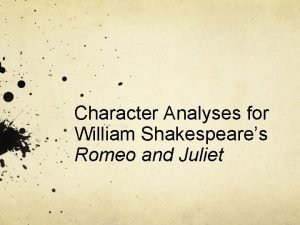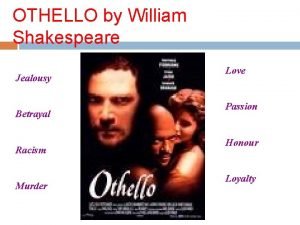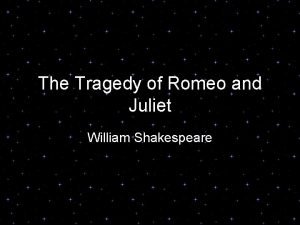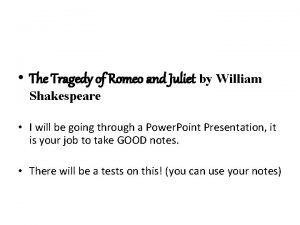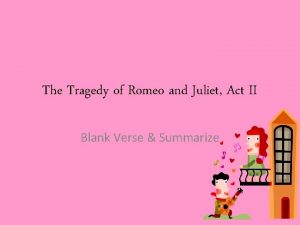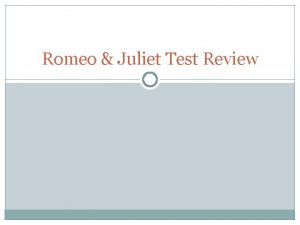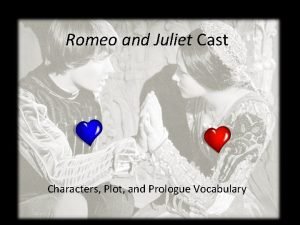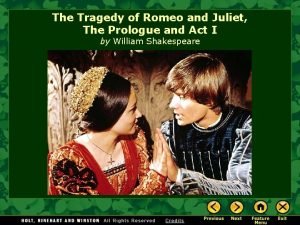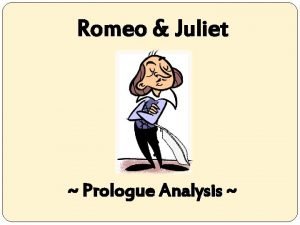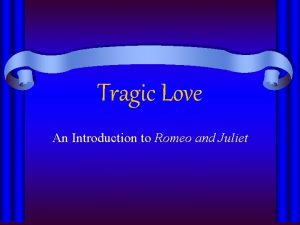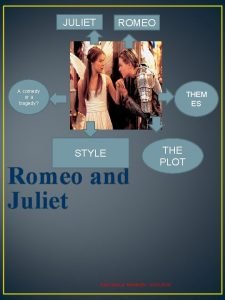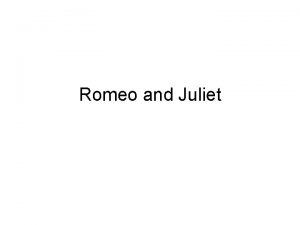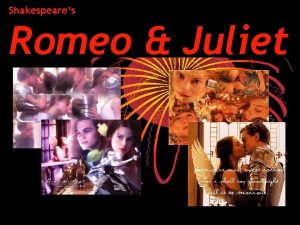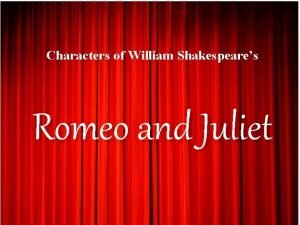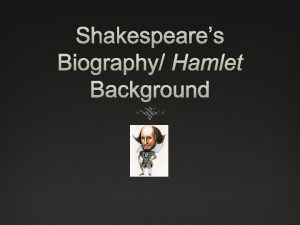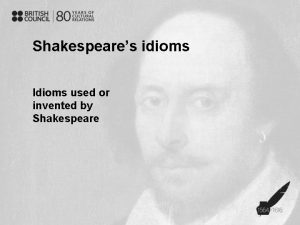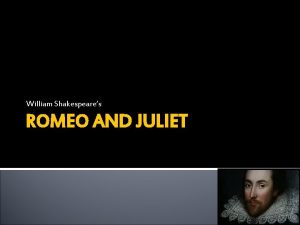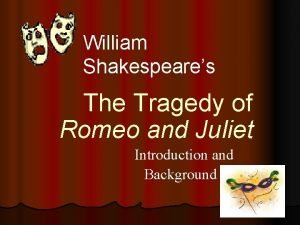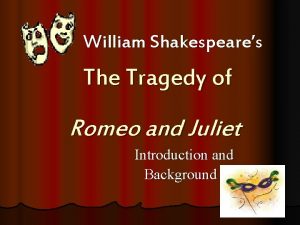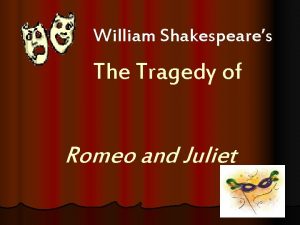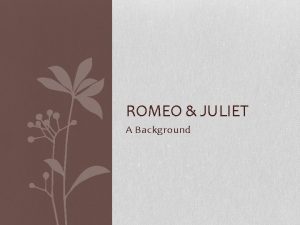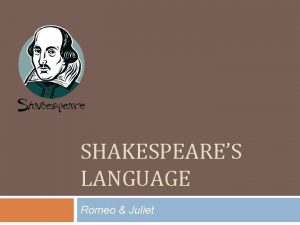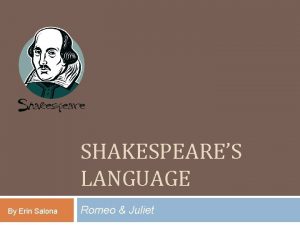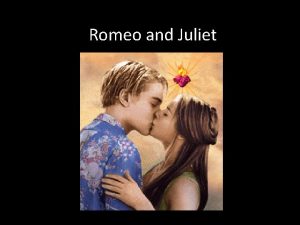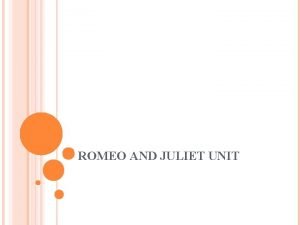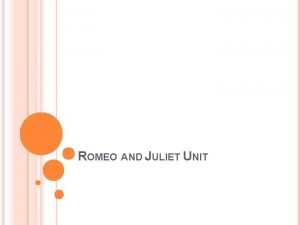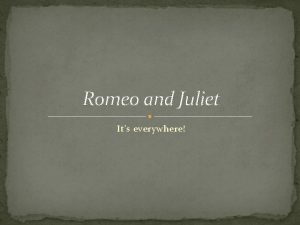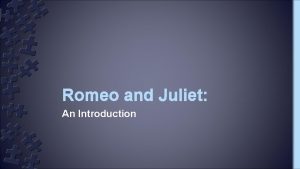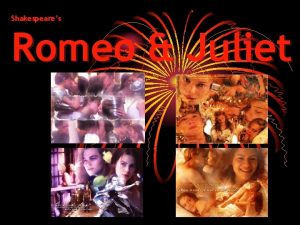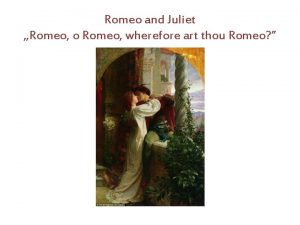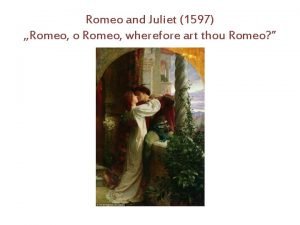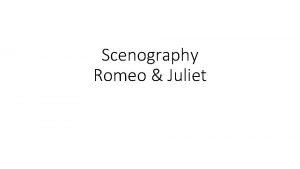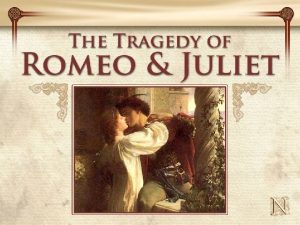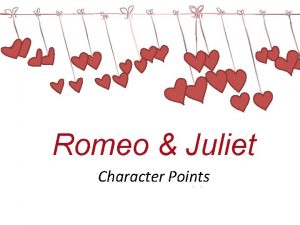William Shakespeares The Tragedy of Romeo and Juliet






















- Slides: 22

William Shakespeare’s The Tragedy of Romeo and Juliet Introduction and Background

William Shakespeare l Shakespeare was born in 1564 and died in 1616. l He grew up in a town called Stratf 0 rdon-Avon and later moved to London to become an actor and playwright.

The Plays l Shakespeare’s plays include comedies, histories—and tragedies such as Romeo and Juliet. l Some of his other famous plays include Julius Caesar, Hamlet, Macbeth, Othello, and A Midsummer Night’s Dream. l In addition, Shakespeare wrote love poems called sonnets.

Will the real Shakespeare please stand up? l Some scholars have suggested Shakespeare, who had little formal education, could not have written such powerful and creative plays. l However, nobody in Shakespeare’s day thought to question his authorship. Apparently, he was just a genius!

Theater l The theater in Shakespeare’s day was tremendously different from what we see today. l Being an actor was not a highly regarded profession; actors were looked down upon in society.

The Globe Shakespeare’s plays were performed in a theater called the Globe— sometimes called “The Wooden ‘O’” because of its circular shape.

l Theaters had no lighting, so performances took place during the day. l There were few special effects or props; Shakespeare used detailed verbal description to paint a picture of his scenes. The reconstructed stage of the Globe

Actors and Actresses l In Shakespeare’s time, it was considered immoral for a woman to appear onstage. So the female roles in Shakespeare’s plays were performed by young men. Queen Elizabeth I

time period in which Shakespeare lived—the Elizabethan period (1558– 1603), 1558– 1603) named for queen Elizabeth—influenced the content of his plays as well as the way in which they were performed. Context l The • • The Renaissance. Cultural and artistic movement in England

Marriage l In Shakespeare’s day, marriages were generally contracts set up by the parents. l When Juliet’s parents arrange a marriage for her, it seems strange to us; Shakespeare’s audience would have thought it was completely normal.

Tragedy l Shakespeare’s tragedies also follow a pattern that would have made sense to his audience. l Elizabethans believed that people’s decisions and mistakes always had consequences, and that people sometimes had to pay a high price for their mistakes. l In Shakespeare’s tragedies, the main characters make decisions that upset the proper order of their world and so affect them and everyone around them. The situation is resolved only when others learn lessons from the main characters’ deaths.

Why we read… l So why do we still read plays like Romeo and Juliet? When Shakespeare’s world was so different from ours, what can we learn from his plays? l Well, the plays are not only great, powerful stories—they also teach lessons about life that apply to people in all cultures and time periods, and those lessons can help us when we come across hard times in our own lives.

Keep in Mind: l Don’t be alarmed by the old-fashioned language: this is really a play about people who are a lot like us, and the difficult words, when you look at them carefully, express emotions anyone can understand. l And remember, the play is POETRY: it’s not supposed to be written exactly the way people talk. The poetry is part of what makes it beautiful and powerful—and worth reading.

Reading the Play Two things to know: l Sometimes a character will give a long speech l Shakespeare’s plays were all by herself, revealing meant to be performed— her secret thoughts to they were some of the most the audience: this is popular entertainment of called a soliloquy. their time. So when we l Sometimes a character read the play, the point is to will just make a brief try and imagine it comment to the happening onstage! audience that the other characters don’t hear; Because of the minimal props and scenery, this is called an aside. the action in Shakespeare’s plays had to be conveyed through words and conversations. A conversation between characters is called DIALOGUE.

So Who’s Who Here? First of all, all of the characters in Shakespeare’s plays can have LOTS of characters. Let’s try to get them straight in our minds… Romeo and Juliet are arranged around a central conflict between two rival families: the Montagues and the Capulets.

The Montagues Romeo Montague Romeo’s Dad Lady Montague Romeo’s mother Mercutio Romeo’s best friend Benvolio Romeo’s cousin

The Capulets juliet Capulet Juliet’s father Lady Capulet Juliet’s Mother Tybalt Nurse Juliet’s cousin Juliet’s nanny

The Peacemakers: The Prince of Verona: Friar Lawrence: l This ruler tries to l This religious leader is mediate between the respected as a holy man by feuding families. both sides, and would like to see them reconciled. l He is pretty tired of all the bloodshed caused byl As a friar, he’s interested not their “ancient grudge. ” only in religion, but also in medicinal herbs—which becomes important later.

And finally… One other “character”: The Chorus is not a part of the action, but a speaker who comes onstage to make comments on the action. The Chorus is kind of like a TV announcer in contemporary life—as far as the characters know, the chorus doesn’t exist, but he helps explain things to us.

Elements of drama l l l Soliloquy: character reveals thoughts and feelings; audience hears his/her thoughts. Aside: character speaks directly to the audience or a specific character- no one else can hear; usually short Monologue: long speech given by a single character Tragedy: drama; gives the audience an experience of CATHARSIS (cleansing/purging of emotion). Tragic flaw: serious character flaw which leads to a character’s downfall

Lit terms l Allusion- a reference to a well-known person, place, work of art or literature l Paradox- a statement that contradicts itself. contradictory words that are separated by one or more intervening words. l contains l. O l that deceit should dwell/In such a gorgeous palace! Dramatic irony- the audience knows something the character does not l Oxymoron- a figure of speech combining contradictory expressions (two words) l “honorable villain”

More. . l l Foil: a character who contrasts with another character in order to highlight particular qualities of the other character Couplet: Two lines of verse, usually in the same meter and joined by rhyme, forming a unit Blank Verse: Verse without rhyme, esp. that which uses iambic pentameter. Pun: play on words l “You have dancing shoes / With nimble soles; I have a soul of lead…"(1. 4. 13 -15)
 Mercutio meaning
Mercutio meaning Envy as a theme in literature
Envy as a theme in literature Shakespeares tragedy about racism and jealousy
Shakespeares tragedy about racism and jealousy William shakespeare’s ‘romeo and juliet’ is a ______.
William shakespeare’s ‘romeo and juliet’ is a ______. The tragedy of romeo and juliet by william shakespeare
The tragedy of romeo and juliet by william shakespeare Romeo and juliet oh romeo
Romeo and juliet oh romeo Why is romeo and juliet a tragedy
Why is romeo and juliet a tragedy The tragedy of romeo and juliet
The tragedy of romeo and juliet Romeo and juliet blank verse
Romeo and juliet blank verse Romeo and juliet test with answer key
Romeo and juliet test with answer key Plot of romeo and juliet
Plot of romeo and juliet Summary romeo and juliet
Summary romeo and juliet Prologue of romeo and juliet act 1
Prologue of romeo and juliet act 1 Iambic pentameter romeo and juliet
Iambic pentameter romeo and juliet Prologue romeo and juliet analysis pdf
Prologue romeo and juliet analysis pdf Romeo juliet introduction
Romeo juliet introduction Romeo and juliet comedy
Romeo and juliet comedy William shakespeare wrote romeo and juliet
William shakespeare wrote romeo and juliet Facts about juliet
Facts about juliet Dramatis personae romeo and juliet
Dramatis personae romeo and juliet Shakespeares career
Shakespeares career Hamlet born
Hamlet born Shakespeares idioms
Shakespeares idioms
